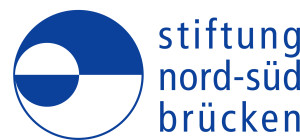The long ignored prelude to the European migration crisis
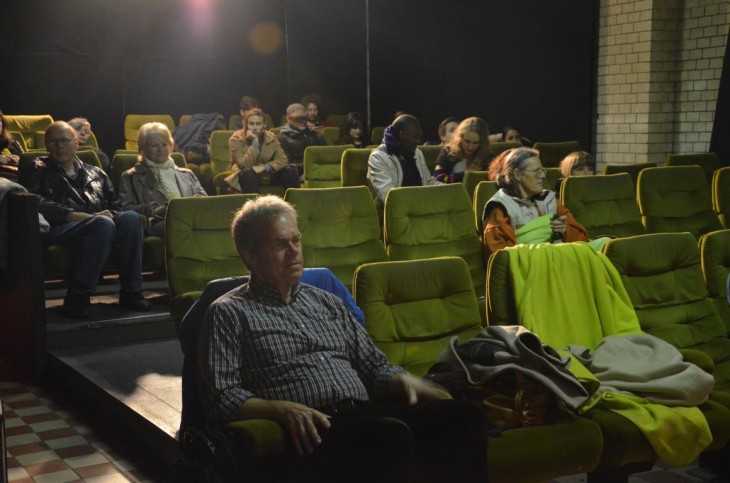
Thousands of refugees are crossing the border daily into Germany in search of a more secure future. Unlike Germany, in Europe this situation is well-known. The 6th evening in our Film and Discussion Series for 2015 featured Gerardo Olivares’ Film “14 Kilometers – The Pursuit of Happiness” as well as Harald Glöde from Borderline Europe in a panel discussion. As the evening unfolded, we saw that the latest developments filling the news today have long been foreseeable, and could have been far earlier addressed by policies.
The film, “14 Kilometers – The Pursuit of Happiness,” accompanies three refugees – Violeta from Mali, along with the two brothers, Buba and Mukela from Niger – on their difficult journey to Europe. From the outset, it is clear that all three have put everything on the table for this journey. The challenges of life as a refugee are clear from the very beginning in Agadez. To get from here to the Algerian border, passengers load into a truck headed for Algeria, constantly harassed at arbitrary checkpoints by corrupt border officials. Those who run out of cash are left to be exploited, working the worst jobs to survive and keep their hopes of onward travel alive. Having fled the prospect of a forced marriage, Violeta ultimately finds herself faced with sexual exploitation on her travels.
Explotiation, danger, and an irrepressible will
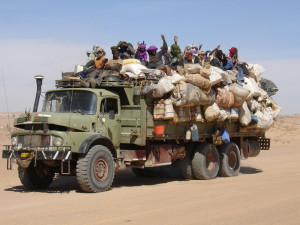 The truck halts in Ténéré desert, northern Niger. The three travellers are facing a walk through the desert (“heading northwest”), aiming for the Algerian Tamanrasset, while the truck continues onwards in a different direction. Violeta, Buba and Mukela become lost. Unable to find the border town between Niger and Algeria, they run circles before falling exhausted under the shade of some acacias. At the last minute, passing Tuaregs are able to save Violeta and Buba. For Mukela, the help arrives too late. On the unforgiving route to Europe, one of only sources of solace is the unconditional hospitality of the traditional, nomadic tribes.
The truck halts in Ténéré desert, northern Niger. The three travellers are facing a walk through the desert (“heading northwest”), aiming for the Algerian Tamanrasset, while the truck continues onwards in a different direction. Violeta, Buba and Mukela become lost. Unable to find the border town between Niger and Algeria, they run circles before falling exhausted under the shade of some acacias. At the last minute, passing Tuaregs are able to save Violeta and Buba. For Mukela, the help arrives too late. On the unforgiving route to Europe, one of only sources of solace is the unconditional hospitality of the traditional, nomadic tribes.
Onwards, towards the Algerian-Moroccan border, Violeta and Buba manage to cross the frontier after several attempts, taking advantage of the chaotic bureaucracy. In Morocco, we find the first state authority who does not exploit the refugees, even going so far as to help them. Once in Tangiers, Violeta and Buba give the last of their money to a well-dressed people smuggler who offers to transport them across the Straits of Gibraltar. But after a successful crossing, there is not much time to celebrate. With police in hot pursuit, Violeta and Buba seek cover in the woods, before noticing the Civil Guard officials have turned a blind eye. While they can now travel undisturbed, the refugees realise an uncertain future awaits them.
Shot back in 2008, the film shows the long ignored prelude to the present European migration crisis – particularly in this last scene, which aptly highlights the current state of Europe’s external borders.
Different escape routes, similar reasons to escape
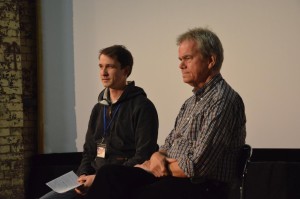 According to Harald Glöde (Borderline Europe) in the post-film audience discussion, the film closely reflects current realities. However, this particular route from Morocco is rarely taken today, with Frontex ships and strict controls blocking passages through the Straits of Gibraltar or to the Canary Islands. Yet, unperturbed by the high, NATO-enforced fences surrounding Ceuta and Melilla, thousands of refugees remain poised in the mountains ready to cross en masse, even if only a few make it across at a time. But as state structures weaken in Mali and Algeria and insecurity grows in the face of Islamist threats, fewer refugees are venturing down such dangerous paths today.
According to Harald Glöde (Borderline Europe) in the post-film audience discussion, the film closely reflects current realities. However, this particular route from Morocco is rarely taken today, with Frontex ships and strict controls blocking passages through the Straits of Gibraltar or to the Canary Islands. Yet, unperturbed by the high, NATO-enforced fences surrounding Ceuta and Melilla, thousands of refugees remain poised in the mountains ready to cross en masse, even if only a few make it across at a time. But as state structures weaken in Mali and Algeria and insecurity grows in the face of Islamist threats, fewer refugees are venturing down such dangerous paths today.
Nowadays, the main migration route from Sub-Saharan Africa goes through Agadez, directly towards Libya, where militias finance vast smuggling operations. According to Sea-Watch, there are two well-known transit points where Europe could be directing humanitarian aid. The first is in Libya, from where around 150,000 have journeyed to Italy this year. The other is Greece, which has served as a contact point to the EU for over 450,000 people – not only because the EU’s Dublin regulations have been de facto overruled and refugees are being allowed to travel onwards through Europe, but also due to the simple proximity of Greece to Turkey, where millions of Syrians are already seeking refuge.
New Syrian refugees in Europe do not have many other alternatives. In North Africa, Morocco alone is the only country where Syrian refugees can live legally, supported by UNHCR. Algeria, Tunisia and Egypt offer no asylum procedures that would open new perspectives. Here, Syrian refugees face disenfranchisement and discrimination, with few informal labour opportunities. Even richer Arab states show little interest in welcoming large numbers of Syrian refugees.
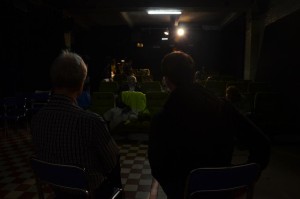 Unlike Syrians, however, those leaving sub-Saharan African may be differently motivated, and are more often on the move due to the lack of future prospects in their homelands. Europe cannot be absolved of responsibility for this state of affairs: fisheries agreements, milk powder and meat exports have all impacted on the African economies. Climate change further impacts on livelihoods. As a result, refugees are fleeing despair not only in Syria, Eritrea, Afghanistan, Pakistan, Iraq and Somalia, but also in countries such as Nigeria, Chad, Ghana and Kenya.
Unlike Syrians, however, those leaving sub-Saharan African may be differently motivated, and are more often on the move due to the lack of future prospects in their homelands. Europe cannot be absolved of responsibility for this state of affairs: fisheries agreements, milk powder and meat exports have all impacted on the African economies. Climate change further impacts on livelihoods. As a result, refugees are fleeing despair not only in Syria, Eritrea, Afghanistan, Pakistan, Iraq and Somalia, but also in countries such as Nigeria, Chad, Ghana and Kenya.
Military, humanitarian and political measures
Asked whether it was possible to improve the safety of current migration routes, Harald Glöde rejected the idea that improvements could be made under current policies. Symbolic polices will continue, but will have little positive effect. Suggested solutions like asylum centres in Greece and Italy will not solve the problem. The audience clearly agreed that refugees could not simply be sent “between camps as packages!” The EU’s plan to resettle 100,000 refugees across Europe was, for Glöde, not sufficient given the current number of refugee arrivals. In any case, having been resettled to countries that persist in marginalising them, refugees would move on to safe third-countries at any cost. Moreover, he pointed out that, despite the EU border countries’ pleas, Germany refused to reform the Dublin system for many years. As Spain, Greece, Hungary and Italy were left to fend for themselves, Germany sat contentedly behind its buffer states. It is only now, when Germany finally feels the pinch herself, that she is pushing for reform. It seems that the only sustainable long-term solution to the crisis is to foster legal migration routes for refugees.
Renaming the European Union Naval Force (EU NAVFOR Med) as “Opeation Sofia” represented another symbolic gesture for Glöde, after a young girl was rescued by a military ship off the Libyan coast on 22 August 2015. Giving the military operation such a name serves as a mere attempt to give it a human face. The Libya operation is geared around three goals (1) Education (2) Redirection (3) Destruction of the smuggling boats. By October 2015, phase 2 was underway, but with no date for the third phase in sight. Indeed, navy operations by Frontex and coastguards were being matched by civil society: Sea-Watch, MSF (two ships), and a Maltese millionaire’s own private rescue ship!
Motivations behind the refugee policies
Asked whether arson attacks on refugee settlements and groups such as Pegida negatively impact on efforts to help refugees in Germany, Glöde argued that “Pegida is a Saxon problem.” One should not forget the positive energies set free. The politicians were “light years away from the a welcoming culture expressed in civil society.” In that sense, Angela Merkel’s commitment to welcoming hundreds of thousands of refugees into Germany should be seen in the light of foreign policy, where it boosts Europe’s international prestige and Germany’s role as a leading nation in Europe rather than a well thought through policy on how to best accommodate and integrate a mass influx of refugees.
Event coordination and presentation: Andreas Fricke
Coordination of the Film Series: Andreas Fricke
Text: Steffen Benzler
Translation: Alex Odlum
Photos: Jana Vietze
Organisation: The Volunteer 14km Film Crew
At 11 and 12 July 2014 14km e.V. was hosting a symposium on “Displacement // Migration // Development” to discuss facets of migration between North Africa and Europe with human rights activists, scientists, fellows of diaspora organizations and interested participants. The report can be found here in German language.
Additional informations:
- Nahrain Al-Mousawi (EUME) works currently on her book about migrant stories about the geographical borders Mediterranian Sean and Sahara. Both natural divides are analised as dividing as well as uniting for the affected humans.
- Reiner Klingholz and Stephan Sievert analyse factors steering the migration to Europe: “Crisis on Europe’s Southern Borders” (Berlin Institute for Population and Development 2014)
- Paul Collier (2013): “Exodus”
- Ralph A. Austen (2010): “Trans-Saharan Africa in World History”
The 14km Film and Discussion Series 2015 gets sponsorship by budgetary funds of the Federal State of Berlin – Office for Development Cooperation.
The upcoming Film- and Discussion night will be about political pop music in Cairo. On November 18th we will screen the documentary “Electro Chaabi“. Read more.
Further events are scheduled as followed:
18 November / 9 December
The events are dedicatet to a single country or specific topic, in order to give an artistic-documentary impression . The ensuing audience discussion aims to include further informations by an affected person living in Berlin and by an scientific expert, always aiming to make links to North-South relationships.
We express thanks for the support:
| Africa Day’s Impressions | “Die Zeit vergeht wie im Fluge” |
| Africa Day’s Impressions | |
| “Die Zeit vergeht wie im Fluge” |


